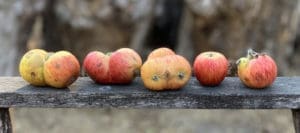This month we turn our eyes to England and an apple that has become a classic, Porter’s Perfection. The Porter in its name is one Charles Porter (1844 – 1932) of East Lambrook, a small village in the Kingsbury Episcopi parish of the southwestern English county of Somerset.
Charles started his working life as a gardener. By 1881 he was farming 20 acres in East Lambrook, probably a mixture of cropland, livestock and orchards, mostly apples. And, like his farming neighbors, he made cider. That’s who was making most of the cider in England in those days, small farmers with mixed farms, using both equipment and techniques that had for the most part not changed in centuries. Cider, which had once graced the tables of lords and ladies, was now often seen as a mixed bag, some clean and good but often deeply flawed, and its market was limited.
Promoters of agricultural improvement believed that science could be the means to make cider better and improve the finances of farmers in the process. In 1893, the trustees of the Bath and West Society, founded in the late 18th century to advance local agriculture, gave a Somerset-based engineer that was studying cider the financial support needed to hire a professional chemist who could look at all aspects of cider and apples in a systematic and detailed manner. They also started a cider competition with the stated goal of encouraging the improvement of cider by awarding cash prizes to the best that met certain minimum standards, a competition that is still being held today.
Within a decade this work had caught the attention of the Board of Agriculture, and with monies from the Board, as well as from various apple-growing counties in the west of England, a farm suitable for experimentation was identified at Long Ashton near Bristol, and the National Fruit and Cider Institute (later the Long Ashton Research Station) was launched. This hugely influential body continued to conduct research on cider for the next 80 years, mostly under the leadership of Bertie T. P. Barker.
It is here that our story loops back to Porter’s Perfection, because it was Barker who brought the apple to public notice after learning of it much by accident. He was searching for apples for the year’s experiments when Charles Porter pointed out a seedling tree that he thought might do. Barker gave it a try, and, he wrote later, “the cider made from it proved to be of such excellent quality that each year since that time … the fruit has been procured for trial purposes … the results have on the whole been so good that it is justifiable to regard the variety as one of the best kinds yet tested for the production of a medium brisk [by which he meant acidic], light, bottling cider.” Barker named it Porter’s Perfection as it was Charles Porter “to whom is really due the credit of having … recognized its merit.” Still popular, the Porter family continues to grow it, as well as other varieties, supplying fruit to Perry’s Cider in nearby Dowlish Wake.
It’s a funny little apple, yellow-green with stripes of red and a thick fleshy stem. Its most remarkable feature, though, is its regular tendency to form fused fruits, usually in twos, but sometimes three or more, hence its other name, Clusters. When walking through an orchard it is hard to imagine mistaking this variety for anything else.
The collection of Porter’s Perfection ciders I tasted through recently – half sparkling, half still – was fascinating, to say the least. None were particularly aromatic, light to medium in their intensity. All possessed notable acid, each showing more than medium briskness, to use Barker’s term, and plenty of tannin, though their colors ranged from yellow to gold to amber.
Where they diverged the most was in their aromas/flavors. Most had some fruit character, tending toward the tart parts like skin or peel, the exception being the cider from Haykin Family Cider, which was rather riper and a little floral. Two, from Eve’s and South Hill, were distinctly savory. What was most interesting to me, however, was how several of the older examples were beginning to develop the tertiary flavors we often associate with aged wines, such as cedar and spice. Certainly these ciders have the acid/tannin structure that suggests they’d age well. It would be worth laying in a few bottles to try again in a year, or two years, or perhaps several more.

Here’s the lineup with some brief notes:
Bauman’s Cider Company – Gervais, Ore.
Tasting Notes: Lemon, lemon peel, pear skin, gooseberry, twigs, granite, wood; sparkling
2019 | 6.9% ABV
Forgotten Ciders – Wheeler, Mich.
Tasting Notes: Plum skin, tart apple skin, blood orange peel, gooseberry, cedar, sawdust; sparkling
2015 | 6.3% ABV
Haykin Family Cider – Aurora, Colo.
Tasting Notes: Lemon juice, blood orange juice, guava, ripe apple, ripe pear, rose petals; sparkling (The apples used were grown in Yakima, Wash.)
2018 | 7.7 % ABV
Eve’s Cidery – Van Etten, N.Y.
Tasting Notes: Orange peel, pear, gooseberry, brine, soy sauce, clove, cedar; still
2017 | 8.5% ABV
South Hill Ciders – Ithaca, N.Y.
Tasting Notes: Apple skin, gooseberry, green plum, grass, brine; still
2019 | 8.4% ABV
Liberty Ciderworks – Spokane, Wash.
Tasting Notes: Grapefruit peel, pear skin, green plum, gooseberry, clove, cedar; still
2017 | 7.4% ABV
Liberty Ciderworks – Spokane, Wash.
Tasting Notes: Tart orange, apple skin, gooseberry, grapefruit peel, clove, twigs; still
2019 | 7.5% ABV
A longer form of this article first appeared at allintocider.com.






